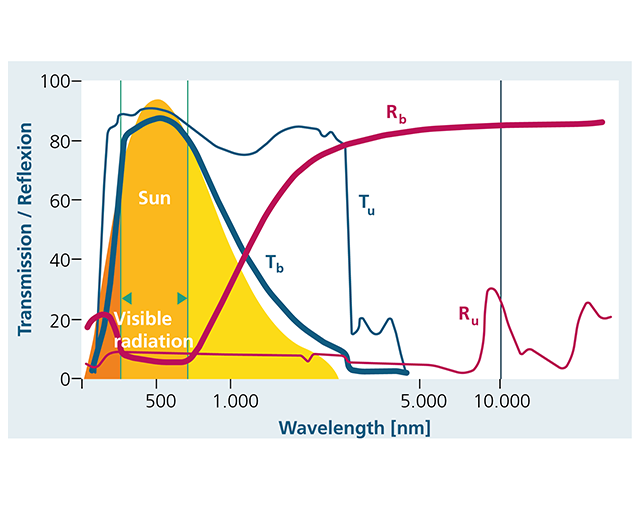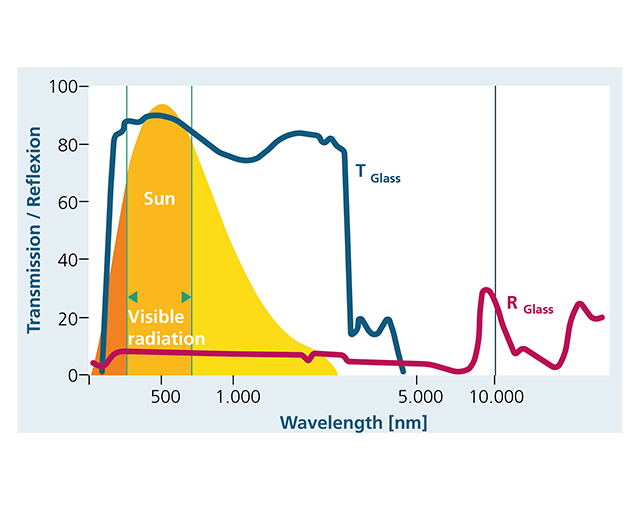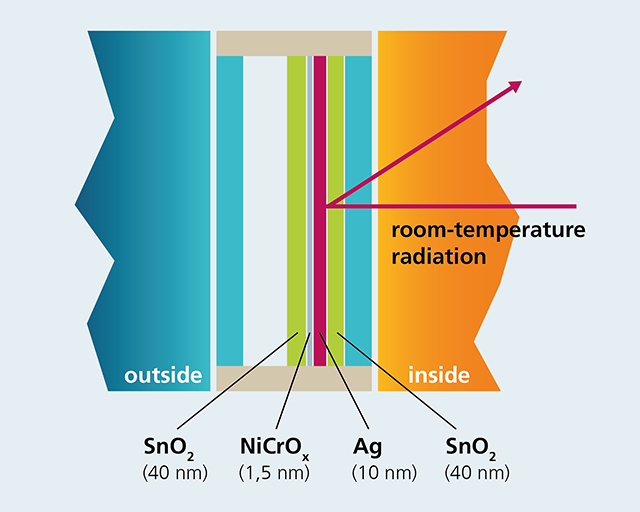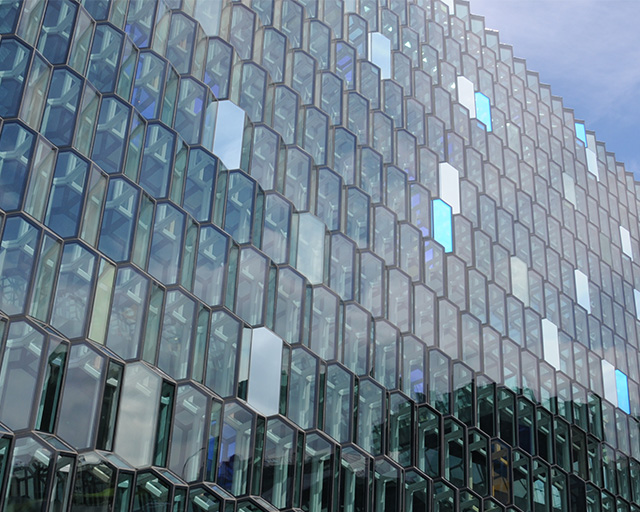Can glass reflect heat?
To come straight to the point: No, assuming it is not coated.
Any body with a temperature above absolute zero (-273.15 °C) emits electromagnetic radiation whose wavelength λ is linked to its absolute temperature T in Kelvin (K) through Wien's displacement law (named after its discoverer, Wilhelm Wien (1864 - 1928)). Evolution endowed us with eyes with which we are able to see a tiny section of the electromagnetic spectrum, namely wavelengths of between around 400 nm and 750 nm. Longer wavelength radiation is perceived by us as heat, whilst shorter wavelength radiation tans our skin and damages it if such radiation is enjoyed to excess. For thermal radiation, we must distinguish between the near (NIR, λ = 780 ... 3,000 nm), mid (MIR, λ = 3,000 ... 50,000 nm), and far (FIR, λ = 50,000 ... 1,000,000 nm) infrared.
The Wien formula (1) provides the maximum of Planck's radiation distribution (which will not be discussed in more detail here for reasons of space), which is specific to each body. The body temperature of a healthy human being is 37 °C or around 310 K; according to Wien, this person's “personal” heat-radiation distribution therefore exhibits a maximum at 9.3 µm, and radiates a power of 100 W (in the case of an unclothed body it would be 200 W, but the clothing, which prevents the person from cooling down, withholds 100 W). Wien's law, incidentally, also provides the surface temperature of the sun in a convenient way, without the necessity of on-site measurement. The maximum radiation distribution of the sun lies at around 500 nm (see Fig. 1), from which a temperature of 5,800 K can be calculated.
But let us return to architectural glass. In this context, the radiation distribution in a heated room plays an important role. At a comfortable temperature of 20 °C, its maximum lies at 10 µm.
When an electromagnetic wave such as light or thermal radiation falls on matter, in particular a pane of glass, the interaction takes place through transmission, reflection and absorption. The three quantities are wavelength-dependent; according to the principle of conservation of energy, their sum is equal to 1 or 100%.
Figure 1 shows the physical properties of flat glass in the wavelength range between around 400 nm and 15,000 nm. The radiation spectrum of the sun is also depicted. For our further considerations, however, the range of room-temperature radiation around 10 µm in the MIR is of interest. In this range T = 0, and the mean value of R is around 15 %. According to (2), the pane therefore absorbs 85% of the incident temperature radiation. Absorption means heating; however, we know from experience that the window pane always remains cold. It seeks thermal equilibrium with its surroundings and therefore continuously transports the absorbed heat energy to the colder outside space.
The heat transfer through a pane of area F, which separates two media with the temperatures T1 and T2, is described by the equation (4). The proportionality factor k is called thermal transition coefficient and in building physics it is referred to as the k-value. Its unit is W/m²K.
In insulating-glass terminology, the k-value was replaced by the Ug-value within the scope of the introduction of the German Energiesparverordnung (Energy-saving ordinance). This did not, however, have any effect on the significance of the thermal transition coefficient from the point of view of building physics.
Single-glazed windows, which are hardly ever found any more in central and northern Europe, have a Ug-value of 5.8 W/m²K. Well-insulated masonry, in contrast, achieves 0.3 - 0.2 W/m²K.
Three stages of a Wärmeschutzverordnung (Thermal-insulation ordinance, WSchVO) in 1977, 1984 and 1995, as well as the Energieeinsparverordnung (Energy-saving ordinance, EnEV) of 2002, have led to a continuous further development of the window as a construction element. In the first stage, single glazing became double glazing or insulated glass units, which led to a reduction in the Ug-value to 3.0 W/m²K. The physical properties of the glass, i.e. the high emissivity, however, remained unchanged.
Polished metal surfaces or metallic coatings not only reflect light but are, as a result of their electrical conductivity, also excellent heat reflectors - right into the far-infrared. Silver achieves reflection values of 98 - 99 % at wavelengths of more than 1,000 nm. For utilization in windows, however, a high light transmission is simultaneously required. Silver layers with thicknesses of around 10 nm also fulfill this requirement. Figure 2 schematically illustrates the structure of a simple thermal-insulation coating. For a long-term stable performance of the window, the silver is “packed” in additional layers. The layer package is only visible when directly compared with the uncoated pane - and even then only to the trained eye.

The effect of the coating in the infrared spectral range is demonstrated in Fig. 3. While the light transmission changes only insignificantly, the reflection capability in the range of room-temperature radiation increases to values greater than 90%, and the emission capability drops correspondingly to values of below 10%. This is referred to as low-emissivity glazing. The typical Ug-value of a coated double-glazed unit is 1.3 - 1.1 W/m²K.
Starting with the first coating variants as shown in Fig. 2, the systems have been continuously modified and further developed in recent years. Silver has remained the core of the coating, and today we find double or triple silver layer stacks with corresponding intermediate layers. The thermal-insulation layers are produced on glass sheets with dimensions of up to 3.21 m x 6.00 m. Several hundred plants are installed worldwide, the most productive of which achieve an annual throughput of 9 million m².
A Ug-value of 1.1 W/m²K by no means represents the limit of what can be achieved. Today, triple glazing with two coated glass surfaces is already in widespread use. With a krypton-gas filling in the spaces between the panes (heavy gases possess low thermal conductivity), their Ug-value lies at 0.5 W/m²K.
The energy balance of thermal-insulation coatings is remarkable: the glazing-related heating-oil consumption drops at a Ug-value of 0.5 W/m²K to less than 10% of uncoated single glazing. The environmental balance sheet of a glass-coating company shows that thermally-insulated coated glass saves 4,000 times more energy during a planned service life of 30 years than is required for its manufacture - including the construction of the coating plant (source: Interpane).
The fact that today, glass is increasingly being preferred as a construction material instead of the classic materials concrete or stone, is visible from afar - particularly as regards spectacular architectural projects or in the case of public buildings. Thin-film technology has contributed towards ensuring that building with glass no longer has any disadvantages – even from an energy point of view – and that there are therefore virtually no limits to modern and aesthetic glass architecture.
Last modified:







